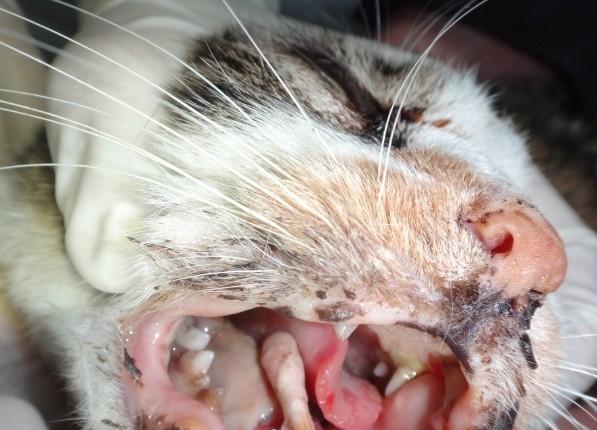Oral ulcer is the inflammation of oral mucosa, which is clinically characterized by salivation, anorexia, flushing and swelling of oral mucosa. It is generally localized and sometimes involves the tongue, gingiva, buccal mucosa and other places, becoming diffuse inflammation. There are many causes of oral ulcer, including physical factors, chemical factors, microbial factors, and secondary to other diseases. The disease is more common in dogs and cats, and more common in cats. Cats like to eat fish, which is easy to stab the mouth and easily cause oral inflammation without timely treatment. The initial symptoms were anorexia and mastication disorder, and then developed into mucosal redness, swelling and heat pain, salivation, bad breath, mucosal ulceration and necrosis, increased body temperature and weakened physique. Recently, there was a cat with severe oral ulcer and varying degrees of necrosis of the mucosa. The diagnosis and treatment in the hospital are as follows. I hope it can help you< Br > < strong > I. Case Introduction
< / strong > a domestic cat, 8 years old, weighing 2.6kg, has not been immunized. She ate fish three days ago, and no foreign bodies such as fish bones were found. After that, she became anorexic and drank water, but her mouth smelled and there was a large amount of salivation. She checked that there were multiple ulcers on her mouth and tongue (as shown in Fig. 1), a large area of ulcers on her gingiva (as shown in Fig. 2), and ulcers and necrosis on her lower lip corner (as shown in Fig. 3). The cat is depressed, weak in limbs and weak in cry.
Figure 1 multiple ulcers on the tongue surface (as shown by the arrow)

Figure 2 large area gingival ulcer (as shown by black arrow) and swelling of sublingual gland (as shown by red arrow)
Fig. 3 large area ulcer and necrosis of lower lip corner
< strong> II. Diagnosis and treatment
< / strong > according to the clinical diagnosis, the cat has multiple localized ulcer foci on the tongue, large areas of grayish yellow pseudomembrane on the oral mucosa, bad breath, and a lot of salivation. According to the owner's description, the cat is diagnosed as ulcerative necrotizing stomatitis< Br > the treatment principle of this disease is to eliminate the cause and strengthen nursing. First, clean the oral cavity, add ceftiofur and Tinidazole into normal saline, clean the oral cavity with cotton swab dipped in normal saline, and rinse once a day. Because cats cannot eat, they should be given intravenous infusion, supplemented with glucose, amino acid and other preparations for maintenance therapy. Ceftiofur should be injected every day for seven consecutive days, and metronidazole tablets should be taken orally. Metronidazole and Tinidazole belong to the nitroimidazole group, which are a group of antigenic and antibacterial drugs. At the same time, they also have strong anti anaerobic effects and can be used to prevent and treat systemic and local infections caused by anaerobic bacteria. At the same time, lack of vitamin B can also cause stomatitis and cheilitis. Therefore, daily subcutaneous injection and oral administration of compound vitamin B can play a certain auxiliary role. After seven days of treatment, the cat's condition improved, her salivation was significantly reduced, and she could eat an appropriate amount of liquid food< Br > local lesions can also be rinsed with 0.1% potassium permanganate or 2% - 3% boric acid solution twice a day. When there is too much oral secretion, you can also use 3% hydrogen peroxide or 1% alum solution to rinse, and smear 5% iodine glycerin on the oral ulcer surface. For ulcers that cannot be cured for a long time, 5% - 10% silver nitrate solution can be applied to corrode and promote their healing. Vitamin A can be used to enhance mucosal resistance. Clean water shall be provided daily, sufficient B vitamins shall be supplemented, and nutritious milk, fish soup and other liquid foods shall be fed to reduce the irritation to the oral mucosa of the affected part.
< strong > III. diagnosis and treatment experience
< / strong > stomatitis is divided into ulcerative, necrotic, fungal and vesicular stomatitis according to its inflammatory nature< Br > 1. Ulcerative stomatitis: it is often complicated with or secondary to systemic diseases. At the initial stage, it mostly secretes transparent saliva. With the development of the disease, it secretes viscous, brown or blood colored saliva and has an unpleasant odor. The above secretion is attached to the mouth, nose and forelimbs< Br > 2. Necrotizing stomatitis: in addition to a large number of necrotic tissues in the mucosa, the ulcerated surface is covered with dirty grayish yellow oily pseudomembrane< Br > fungal stomatitis: it is a special type of ulcerative stomatitis, characterized by white or gray oral mucosa and spots slightly higher than the surrounding tissues. The surrounding of the focus is flushed, and the surface is covered with a white tough film. It often occurs in dogs and cats with a long-term or high-dose history of using broad-spectrum antibiotics< Br > 3. Vesicular stomatitis: it is often accompanied by systemic diseases, such as canine distemper, malnutrition, etc. small vesicles appear in the oral mucosa, which gradually develop into bright red ulcer surface and the focus boundary is clear. When cats suffer from this disease, there are also obvious lesions in their mouth corners< Br > < strong> IV. preventive measures
< / strong > to prevent this disease, cats should be carefully taken care of, and it is best to feed special cat food to prevent vitamin deficiency caused by malnutrition. And pay attention to removing foreign matters in the cat's food to avoid mucosal damage caused by accidental ingestion. On weekdays, observe whether the cat's activities are abnormal, and treat it in time if found.
